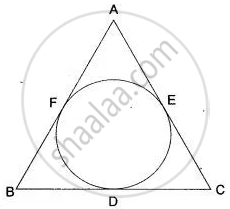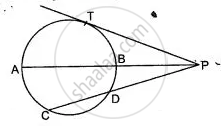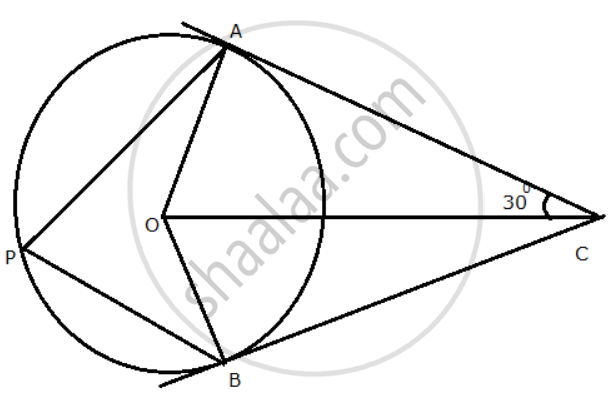Advertisements
Advertisements
Question
In Fig. the incircle of ΔABC touches the sides BC, CA, and AB at D, E respectively. Show that: AF + BD + CE = AE + BF + CD = `1/2`( Perimeter of ΔABC)

Solution
Since lengths of the tangents drawn from an exterior point to a circle are equal.
∴ AF = AE ...(i)
BD = BF ...(ii)
and CE = CD ...(iii)
Adding (i), (ii) and (iii), we get
AF + BD + CE = AE + BF + CD
Now, Perimeter of Δ ABC = AB + BC + AC
= (AF + FB) + (BD + CD) + (AE + EC)
= (AF + AE) + (BD + BF) + (CD + CE)
= 2AF + 2BD + 2CE
= 2( AF + BD + CE) ....(From (i), (ii) and (iii), we get AE = AF, BD = BF, and CD = CE)
∴ AF + BD + CE = `1/2`( Perimeter of ΔABC)
∴ AF + BD + CE = AE + BF + CD = `1/2`( Perimeter of ΔABC)
Hence proved.
APPEARS IN
RELATED QUESTIONS
A tangent PQ at a point P of a circle of radius 5 cm meets a line through the centre O at a point Q so that OQ = 12 cm. Length PQ is ______.
A circle touches all the four sides of a quadrilateral ABCD. Prove that AB + CD = BC + DA.
Two chords AB and CD of lengths 6cm and 12cm are drawn parallel inside the circle. If the distance between the chords of the circle is 3cm, find the radius of the circle.
The length of the direct common tangent to two circles of radii 12cm and 4cm is 15cm. calculate the distance between their centres.
PA and PB are tangents from P to the circle with centre O. At M, a tangent is drawn cutting PA at K and PB at N. Prove that KN = AK + BN.
In the given figure, diameter AB and chord CD of a circle meet at P. PT is a tangent to the circle at T. CD = 7.8 cm, PD = 5 cm, PB = 4 cm. Find the length of tangent PT.

In the given figure, O is the centre of the circle. Tangents at A and B meet at C. If angle ACO = 30°, find: angle AOB

Two circle with radii r1 and r2 touch each other externally. Let r be the radius of a circle which touches these two circle as well as a common tangent to the two circles, Prove that: `1/sqrtr + 1/sqrtr_1 + 1/sqrtr_2`.
In figure, AT is a tangent to the circle with centre O such that OT = 4 cm and ∠OTA = 30°. Then AT is equal to ______.

The quadrilateral formed by joining the angle bisectors of a cyclic quadrilateral is a ______
